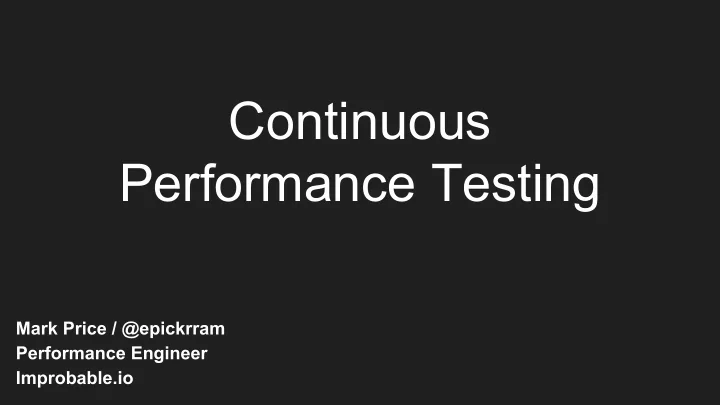

Continuous Performance Testing Mark Price / @epickrram Performance Engineer Improbable.io
The ideal System performance testing as a first-class citizen of the continuous delivery pipeline
Process
Process maturity A scientific and rigorous survey
Process maturity A scientific and rigorous survey
Process maturity “As part of QA, the whole team logs on to the system to make sure it scales”
Process maturity “We have some hand-rolled benchmarks that prove our code is fast”
Process maturity “We use a well-known testing framework for our benchmarks”
Process maturity “Our benchmarks are run as part of CI”
Process maturity “Trend visualisations of system performance are available”
Process maturity “There is a release gate on performance regression”
Increasing process maturity Implies: Higher maintenance cost Greater confidence
Scopes
Performance test scopes ● Nanobenchmarks ● Microbenchmarks ● Component Benchmarks ● System performance tests
Nanobenchmarks ● Determine the cost of something in the underlying platform or runtime ● How long does it take to retrieve System.nanoTime()? ● What is the overhead of retrieving AtomicLong vs long? ● Invocation times on the order of 10s of nanoseconds
Nanobenchmarks ● Susceptible to jitter in the runtime/OS ● Unlikely to need to regression test these... ● Unless called very frequently from your code
Message callback @Benchmark @BenchmarkMode(Mode. Throughput ) @OutputTimeUnit(TimeUnit. SECONDS ) public void singleCallback( final Blackhole blackhole) { callback .accept(blackhole); } @Benchmark @BenchmarkMode(Mode. Throughput ) @OutputTimeUnit(TimeUnit. SECONDS ) public void singleElementIterationCallback( final Blackhole blackhole) { for (Consumer<Blackhole> objectConsumer : callbackList ) { objectConsumer.accept(blackhole); } }
Message callback
Microbenchmarks ● Test small, critical pieces of infrastructure or logic ● E.g message parsing, calculation logic ● These should be regression tests ● We own the code, so assume that we’re going to break it ● Same principle as unit & acceptance tests
Microbenchmarks ● Invaluable for use in optimising your code (if it is a bottleneck) ● Still susceptible to jitter in the runtime ● Execution times in the order of 100s of nanos/single-digit micros ● Beware bloat
Risk analysis - long vs double BigDecimal long double
Component benchmarks ● ‘Service’ or ‘component’ level benchmarks ● Whatever unit of value makes sense in the codebase ● Wire together a number of components on the critical path ● We can start to observe the behaviour of the JIT compiler (i.e. inlining)
Component benchmarks ● Execution times in the 10s - 100s of microseconds ● Useful for reasoning about maximum system performance ● Runtime jitter less of an issue, as things like GC/de-opts might start to enter the picture ● Candidate for regression testing
Matching Engine - no-ops are fast!
System performance tests ● Last line of defence against regressions ● Will catch host OS configuration changes ● Costly, requires hardware that mirrors production ● Useful for experimentation ● System recovery after failure ● Tools developed for monitoring here should make it to production
System performance tests ● Potentially the longest cycle-time ● Can provide an overview of infrastructure costs (e.g network latency) ● Red-line tests (at what point will the system fail catastrophically) ● Understand of interaction with host OS more important ● Regressions should be visible
Page fault stalls
Performance testing trade-offs Nanobenchmarks ● Faster ● Slower feedback feedback ● System jitter ● Hardware Microbenchmarks magnified cost ● Fewer moving ● Maintenance parts cost Component Benchmarks ● Stability ● KPI/SLA indicator System Tests ● Realism
Measurement
System jitter is a thing
Reducing runtime jitter Histogram of invocation times (via JMH) Run-to-run variation Large error values around average
Reducing runtime jitter
Measurement apparatus Use a proven test-harness If you can’t: Understand coordinated omission Measure out-of-band Look for load-generator back-pressure
Production-grade tooling Monitoring and tooling used in your performance environment should be productionised
Containers and the cloud Measure the baseline of system jitter Network throughput & latency: understand what is an artifact of our system and what is the infrastructure End-to-end testing is more important here since there are many more factors at play adding to latency long-tail
Reporting
Charting “Let’s chart our benchmark results so we’ll see if there are regressions”
Charting
Charting
Charting
Charting Make a computer do the analysis We automated manual testing, we should automate regression analysis Then we can selectively display charts Explain the screen in one sentence, or break it down
Improvement
Virtuous cycle Measure Compare Model Measure Execute
Virtuous cycle PRODUCTION Measure Compare Model Measure Execute PERF ENV
Virtuous cycle Use the same Measure tooling Compare Model Track Measure Execute divergence
Regression tests If we find a performance issue, try to add a test that demonstrates the problem This helps in the investigation phase, and ensures regressions do not occur Be careful with assertions
In a nutshell...
Key points Use a known-good framework if possible If you have to roll your own: peer review, measure it, understand it Data volume can be oppressive, use or develop tooling to understand results Test with realistic data/load distribution
Key points Are we confident that our performance testing will catch regressions before they make it to production?
Thank you! ● @epickrram ● https://epickrram.blogspot.com ● recruitment@improbable.io
Recommend
More recommend